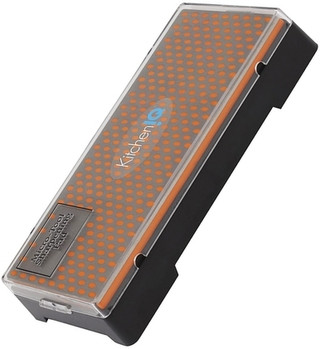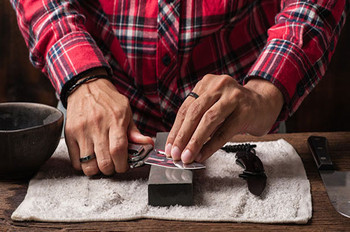How to Sharpen a Knife
Posted by Clayton on Apr 27th 2023

Part of owning a knife is making sure it is maintained well and working properly. Ensuring that your knife is sharp is probably one of the most important parts of maintenance. It is more dangerous to use a dull knife than a sharp knife. When you use a dull knife, you often use more force than normal in an attempt to compensate for the dull edge. If the blade of the knife is freed unexpectedly, then you will likely cut yourself because of compensating for the dull knife. In order to be safe and get the best performance out of your knife, it is important to make sure it is sharp enough.
Sharpening a knife consists of grinding and honing. Grinding is the removal of metal. Honing is when you use an abrasive stone to remove a minuscule amount of metal from the blade. It is more precise than grinding.
A more aggressive grit is used to properly shape the blade of the knife, and a finer grit is used to hone the edge of your blade. Never try to sharpen your knife on something that is not intended for knife sharpening. Something like a powered grinding wheel could make your blade edge brittle and more vulnerable to cracks.
Sharpeners
Diamond knife sharpeners can be used either dry or wet. If you use them wet, use water-based honing fluid or water. Sharpening stones can be used wet or dry, but it is recommended that you use one with water or a honing fluid.
Heavy Sharpening
Look down the length of the edge of your blade and examine its condition. Look for any nicks or chips in the edge. If you see any nicks or the blade is extremely dull, you must start with some heavy sharpening. Use a coarse grit sharpener to fix inconsistencies and ensure the edge is sharp. If there are no inconsistencies, then you can move on to step two.
When grinding the blade, try to follow the edge angle as when the blade was new. As a rule of thumb, hold the blade about one blade width from flat against the stone. When grinding, make sure to always cut into the stone and use 5 strokes per side of the blade. Afterward, check the edge and adjust the angle and stroke as you see fit. Make sure you do not apply too much pressure to the blade, as it can cause micro serrations on the blade and remove grit from the sharpener. Once the drag is consistent from hilt to tip, you can move on.
Medium Grit Sharpening
You use a medium grit sharpening stone after completing heavy sharpening, or if heavy sharpening is unnecessary. Medium grip sharpening is used for touch ups and final sharpening. This step is also used to sharpen normally dull blades and to remove rough scratches.
Make sure your knife is dry first. Sharpening with medium grit is essentially the same as sharpening with heavy grit. Use single strokes from side to side until you cannot feel a burr on either side of the edge. Medium grit sharpening is enough to achieve a sharp edge that is suitable for use. You can fine tune your blade further with fine sharpening.
Fine Grit Sharpening
This stage can be done using a natural sharpening stone or a fine grit sharpener. Fine sharpening will remove any burr that remains. Repeat the same stroking motions as before, until the scratches from the coarser grits are gone. You will probably still feel a burr, but it will be finer and smaller. Make light, single strokes from side to side. You should stroke from hilt to tip, turn the knife over, and stroke again from hilt to tip. Repeat this process until there is no longer any burr.
Sharpening Tips
- Maintain contact between the blade and sharpener. Make sure the tip of your blade does not go off the edge of the sharpener, in order to avoid a rounded tip.
- Use the same number of strokes for both sides of the blade.
- Work nicks separately. Work around nicks in the edge using side to side strokes. When the nick is removed, you can go back to sharpening the entire length of the edge.
Take Away
Ensuring that your knife is well maintained is important for it to function properly. Maintaining a sharp blade will ensure that the knife works properly and safely. Use these steps above to ensure that your knife is sharp enough. Practice, and make a habit of making sure your knife is well maintained.

